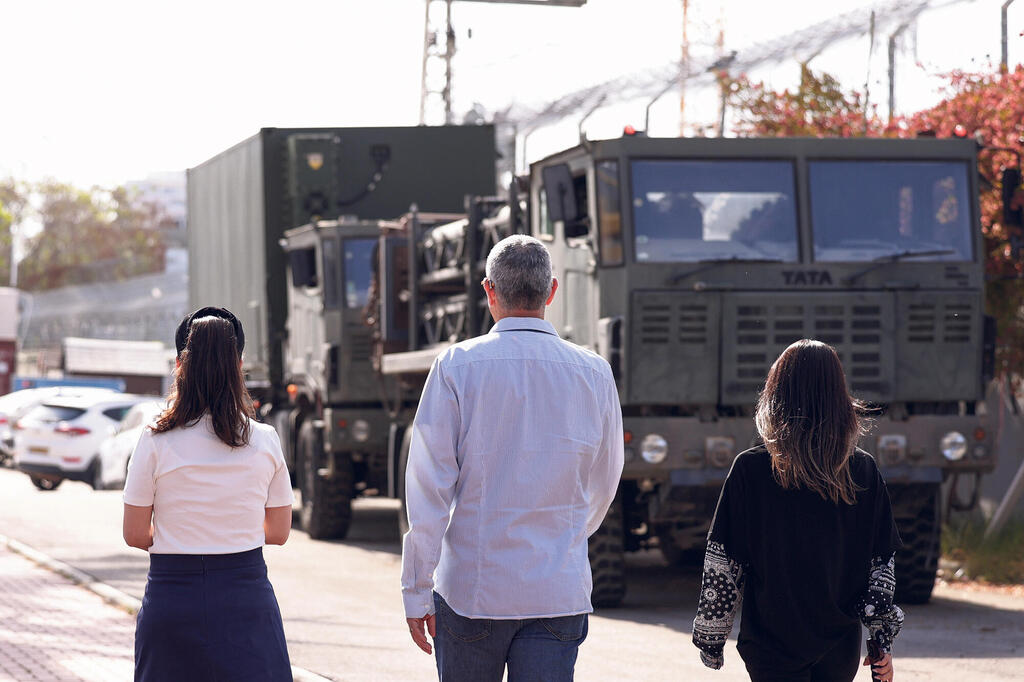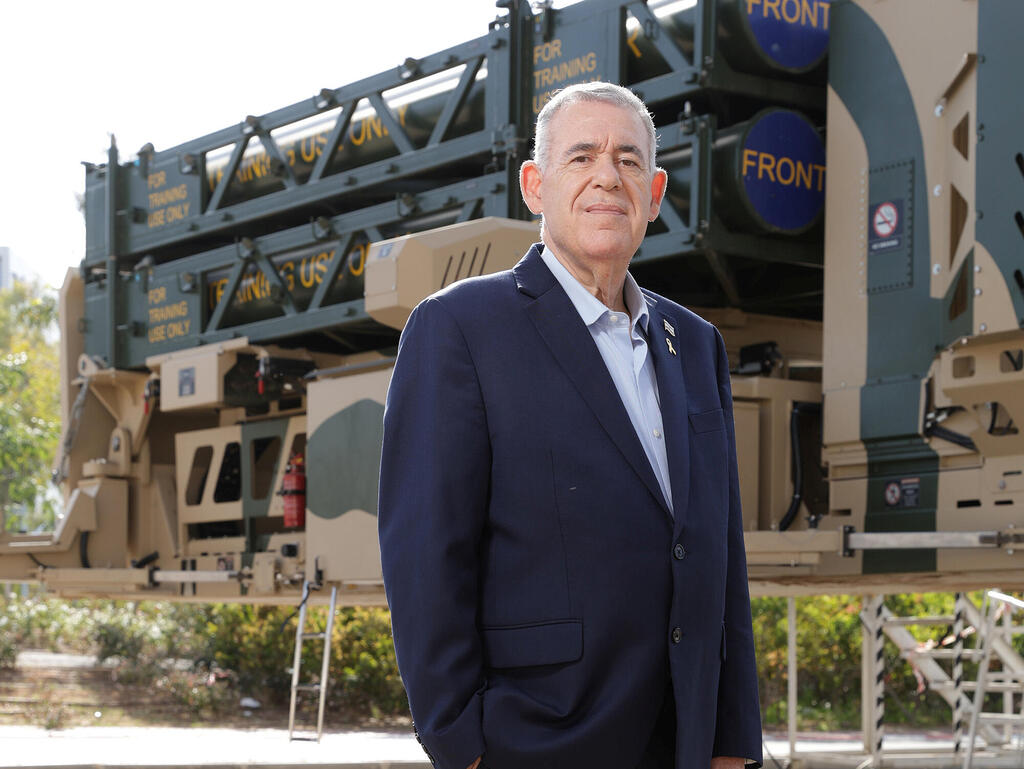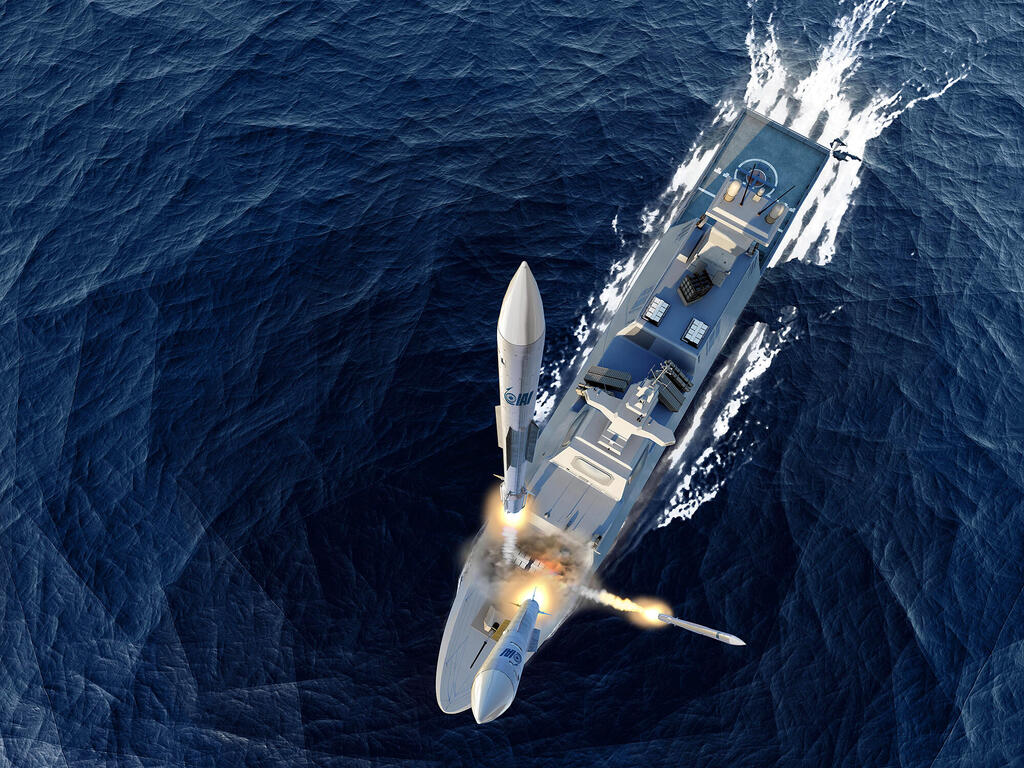
How a hand-drawn sketch became a $10 billion air defense missile system
IAI’s CEO reveals the origin of the Barak MX and how independent development is giving Israel a marketing edge over U.S.-funded systems.
On Sunday of this week, thick smoke was still rising from the Shahid Rajaee port near Bandar Abbas in southern Iran, following a mysterious explosion that had occurred there the day before. That same afternoon, Israeli Air Force planes bombed infrastructure in Beirut’s Dahya district used to store precision-guided missiles.
While Iran and Lebanon were battling flames, hundreds of employees of Israel Aerospace Industries (IAI), accompanied by their families, gathered at the company’s central Israel campus for the traditional ceremony honoring excellence. Certificates were awarded to 32 employees and work teams from IAI’s various divisions.
Among the recipients was M., a standout employee at the defense contractor, which has shifted to emergency operations since the war began, producing weapons around the clock. This pace demands her constant availability, long hours in the development labs and production halls, and personal sacrifice. But she doesn’t complain.
“It's true that many people are in the reserves,” she says, “but I work in a team, and I manage to balance home and work.” She is 35, married with three children, and lives in central Israel. For the past 15 years, she has worked in IAI’s Missile and Space Division. Today, she is an engineer on the Barak MX naval missile system—now deployed on the Navy’s new Sa’ar 6 warships, which became operational during the current conflict.
When she joined IAI as a 20-year-old student, the Barak missile system was still a highly classified concept, nothing more than a sketch in blue ink on a white A4 sheet. “This is the first sketch of the system from 12 years ago,” says its designer, now IAI CEO Boaz Levy. “Three missiles, three ranges. What we wanted is what we built—exactly, one for one.”
At the time of the sketch, Levy was the newly appointed head of the Missile and Space Division. He would later lead key development programs for the Arrow missile defense system and other offensive systems, including the long-range LORA missile. That original sketch now hangs framed on the wall of his office, beside a fragment of an Iranian ballistic missile intercepted a year ago by an Arrow missile.
Over the years, M. watched the Barak MX system evolve from concept to reality—from a hand-drawn blueprint to a cutting-edge missile platform that has become one of IAI’s primary growth engines. “In all these years, I’ve seen the entire ambitious process take shape, transforming from a general plan on paper into a powerful defense system,” she says, moments before stepping onto the stage to receive her certificate. “The satisfaction is immense. Taking this missile out to the test range, witnessing a successful launch, and seeing the customer satisfied—it’s an adrenaline rush. And I’m here for the adrenaline.”
The Barak missiles bring more than excitement—they’re also a financial powerhouse. Over the past eight years, they’ve generated more than $10 billion in contracts, making them the company’s best-selling missile product. IAI also manufactures the Arrow missile defense systems and offensive weapons such as LORA.
“The global arms buildup—spurred by the war in Ukraine and rising threats in other regions—has driven a high volume of deals. And we’re still actively negotiating with additional potential customers worldwide who are interested in our defense systems,” says Levy.
Over the past three years, the number of countries acquiring the Barak MX has steadily grown. At the end of last year, Slovakia purchased several batteries for approximately $560 million. Neighboring Cyprus also acquired two batteries in a deal reportedly signed two years before it was publicly disclosed, though its financial scope was not revealed. These countries joined others, including Azerbaijan, which acquired Barak systems in a $1.2 billion deal. According to foreign media reports, Morocco and the United Arab Emirates have also purchased the system.
In a world rearming at full tilt, Israel’s air defense systems have a competitive edge, thanks to the hard-earned operational experience gained in numerous conflicts. Military planners assume that systems proven effective against Hamas, Hezbollah, Iran, and other pro-Shiite militias in the Middle East will also perform well in future conflicts elsewhere.
Both IAI and Rafael Advanced Defense Systems—the developer of Iron Dome and David’s Sling—recognize their strong positioning in the global market. But as two government-owned Israeli firms, they now find themselves competing directly for high-stakes international contracts.
One such competition is currently unfolding in Greece. IAI and Rafael are anxiously awaiting a decision from the Greek Ministry of Defense, expected in the coming weeks, on whether to purchase IAI’s Barak MX or Rafael’s David’s Sling. The deal is estimated to be worth several hundred million dollars.
IAI’s competitive edge lies partly in price. Barak MX missiles are significantly cheaper than the David’s Sling interceptor, which is estimated to cost around $1 million per unit. Another advantage is IAI’s full independence in marketing the Barak system—unlike other major Israeli air defense platforms, such as Arrow, Iron Dome, and David’s Sling, which were developed with substantial U.S. funding and involve American industrial partnerships.
By contrast, the Barak MX was developed solely with IAI’s own investment of hundreds of millions of dollars.
Developing the Barak missile system independently has given Israel Aerospace Industries (IAI) greater maneuverability in marketing its air defense solutions globally, without relying on formal approvals from external partners.
When IAI signed its first export deal for Arrow 3 missiles with Germany in 2023—worth approximately 14 billion shekels—it marked the largest defense sale in Israeli history. However, the deal's execution depended on approval from the White House, which was secured following direct discussions between then-U.S. President Joe Biden and German Chancellor Olaf Scholz. A similar approval was required earlier that year for the first export deal involving Rafael’s David's Sling system, sold to Finland for 1.3 billion shekels. Even within Finland’s Ministry of Defense, the decision to acquire a new air defense system came down to a choice between Rafael’s and IAI’s offerings.
“You need to have great confidence in a weapons system to fund its development independently,” says Levy. “Compared to other air defense systems, we financed the development of the Barak MX ourselves. We invested hundreds of millions of dollars into it. It’s a fully blue-and-white system—developed, manufactured, and integrated entirely within IAI. The radar comes from our subsidiary Elta Systems, the command-and-control center is produced at MBT (Plant B), and the missiles are built in our Missiles and Space Division. This model has significantly improved our business performance.” The missile engines are manufactured by Tomer, a state-owned company that was spun off from Israel Military Industries (IMI) when IMI was sold to Elbit Systems.
Barak MX: From Concept to Deployment
At IAI’s Barak MX production facility, several launchers are undergoing final adjustments ahead of imminent delivery to an undisclosed international customer. Some are already painted in the camouflage scheme of the receiving army. A launcher appears as a truck-mounted hive of eight cylindrical pods, each containing a missile. Though externally identical, the missiles inside vary, enabling a range of interception capabilities tailored to different threats. The system is designed to intercept at three main ranges—35 km, 70 km, and 150 km. Each interceptor differs in size but is compatible with the same launch cassette, which can be replaced within minutes when empty.
The missiles launch vertically, enabling 360-degree coverage of assigned zones. After liftoff, they adjust midflight to pursue their targets. “You wouldn’t want to be in a fighter jet or helicopter being targeted by one of these interceptors,” says Y., the chief system engineer of the Barak. “Even if you’ve developed countermeasures, they won’t help much.”
Truck-mounted launchers can fire a full salvo within 70 seconds of halting. Fixed launchers deployed in the field can launch within minutes. Wireless communication among system components drastically shortens response times to emerging threats.
When launched from ships to defend naval vessels, the missile dives steeply from high altitude toward the target. “That gives it more kinetic energy and a better visual lock,” explains one of the engineers. “It gives the target virtually no chance to escape.” Upon nearing the target, a proximity fuse activates the 22-kilogram warhead, dispersing thousands of tungsten fragments to create a lethal cloud several meters wide. “No one wants to be in an aircraft when this missile is coming at it,” says one of the Barak program managers at IAI. “This missile doesn’t just hit—it hits hard.”
IAI’s success with the Barak system began in the 1990s, when it co-developed the Barak 1 missile with Rafael to protect Israeli naval vessels from aircraft and sea-launched missiles. The Barak 1, with a range of about 10 kilometers, saw its first operational use only in July 2022—nearly three decades later—when Hezbollah launched three drones toward the Karish gas platform. One was downed by an Israeli Air Force F-16, and the remaining two were intercepted by Barak 1 missiles launched from the Saar 5-class corvette Eilat.
From Barak 1 to Barak 8
Even before Barak 1’s operational debut, IAI had already advanced its capabilities through a strategic partnership with India’s Ministry of Defense. In 2007, then-CEO Itzhak Nissan signed a joint development agreement with India’s Defence Research and Development Organisation (DRDO) for a new naval interceptor missile with a 70-kilometer range, later named Barak 8. The deal, worth approximately $1.5 billion, was among the largest in IAI’s history. The missile engine was developed by DRDO.
Barak 8 became operational with the Indian Navy in 2015 and was integrated into the new generation of Indian destroyers. Operational certification for each ship involves test launches, one of which was successfully completed recently. As the Barak 8 became a central element of India’s naval defense strategy, collaboration between the two countries expanded to include air and land-based variants of the system.
“Our cooperation with all branches of the Indian military is excellent,” says Levy. The missiles and related systems are manufactured locally in India under Prime Minister Narendra Modi’s “Make in India” initiative, which promotes domestic production through technology transfer and joint ventures. In a competitive global defense market, compliance with such local manufacturing requirements has become essential—and more countries are adopting similar policies.
For IAI, the Indian partnership has paid off handsomely, generating several billion dollars in revenues and laying the foundation for the independently developed Barak MX. The ongoing war in Israel—where no air defense system in history has faced such sustained and varied threats—may influence future Barak system upgrades, potentially including missile interceptors capable of exo-atmospheric engagement. IAI’s leadership remains tight-lipped about future plans.
“This system evolves in response to real-world threats,” says Levy. “We’re always looking forward. In the Middle East, you need to counter drones, cruise missiles, ballistic threats, and aerial platforms at various altitudes. These are deadly threats that require devastating defensive capabilities.”
Next-Generation Drone Defense: AI Enters the Battle
The challenges faced by the Israeli Air Force in intercepting drones during the war have triggered a wave of innovation across the IDF, defense ministry, and private defense firms. One promising solution—developed mid-war by the IDF Northern Command and the ICT Corps—is an AI-based system called Shomo Shamayim.
Led by Lt. Col. T., a reservist who is also a civilian project manager at Rafael, the software-based system provides early warnings about drone launches based on historical flight patterns. “Using AI, we can detect trends and intentions. The more data the system absorbs, the more insights we gain,” T. told Calcalist.
The system integrates data from the Air Force’s control units, including launch times, locations, flight trajectories, drone types, altitude, and speed. It now contains data on dozens of drone types, mostly originating from Lebanon. Since its deployment in October 2024 during intense fighting with Hezbollah, it has undergone three major updates and is now being rolled out in the southern sector to monitor smuggling attempts from Egypt and Jordan via drones.
While Shomo Shamayim enhances Israel’s situational awareness, it is not a complete solution. Defense firms and the Ministry of Defense are evaluating additional systems to strengthen detection, identification, and interception capabilities.
Three months ago, nine defense firms demonstrated 20 different solutions at a test site in the Negev. IAI showcased a multi-layered system featuring sensors, distributed interceptors, electric missiles, and a 30mm cannon for drone neutralization. Aerobotics presented a reusable interceptor drone. Rafael demonstrated the Mini-Typhoon, a remote-controlled weapons system. Elbit Systems showed drones capable of intercepting enemy drones mid-air.
Later this year, Rafael is expected to deliver the first Magen Or (Iron Beam) laser systems, designed to intercept short-range rockets and drones. These systems will integrate with Iron Dome batteries, offering a low-cost interception option—just a few shekels per shot—compared to expensive missile interceptors.
















